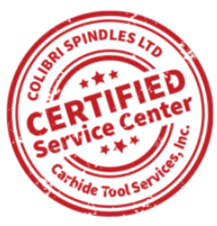Recognizing the Signs of Tool Wear and Production Loss
In high-demand manufacturing environments, even the smallest decline in tool performance can lead to costly delays and reduced productivity. At Carbide Tool Services, we specialize in restoring worn tools to like-new condition, helping you avoid unnecessary downtime and keep production running efficiently.
Signs Your Tools Are Worn and Costing You Productivity
Subtle wear can quickly translate into increased cycle times, compromised tolerances, and unnecessary downtime. Recognizing early warning signs is critical to maintaining tool life. Here’s what to watch for:
Indexable Tools
- Dull Cutting Edges: Dull or rounded cutting edges require higher cutting forces, generate excessive heat, and lead to accelerated wear on both the insert and workpiece surface. This ultimately reduces dimensional accuracy and surface finish quality.
- Small Chips or Fractures: What appears as a minor chip on a cutting edge or toolholder can initiate stress concentrations, increasing the risk of sudden tool failure and machine crashes, especially under high feed or interrupted cut conditions.
- Irregular Noises on the Lathe: High-pitched whining, chattering, or vibration-induced rattling often indicate insert instability, improper seating, or spindle misalignment. These conditions jeopardize part quality and tool integrity.
Live Tools
-
- Excessive Spindle Runout: Runout beyond spec is often caused by worn spindle bearings, shaft misalignment, or heat distortion and can lead to off-center rotation, inconsistent surfaces, poor feature location accuracy, and increased tool wear. This is especially problematic during tight-tolerance turning or milling operations.
- Internal Noise: Clicking, knocking, or grinding noises typically indicate failing bearings, worn gear teeth, or a lack of lubrication within the drive system. These disruptions increase vibration and compromise the transmission, resulting in unstable tool alignment and reduced finish quality.
- High Heat Generation: Excessive heat at the tool head or vibrations felt through the housing are signs of failing seals, degraded grease, or imbalance within the gear train. These issues directly reduce tool life and performance under high-RPM or continuous-use conditions.
- Hidden Internal Damage: Critical failures such as gear wear, shaft scoring, or bearing race deformation, cannot be identified through visual inspection alone. Without routine teardown and component replacement these hidden faults will worsen, leading to sudden tool seizure or spindle crashes.
How Tool Wear Affects Production
Worn tools can lead to:
- Increased scrap rates
- Reduced surface quality finishes due to a worn insert or a disruptive tool edge
- Slower cycle times, affecting output in high volume environments
- Tool crashes, machine damage, and insert breakage
- Higher overall operating costs and production time
These issues can disrupt your production schedule and reduce the return on your equipment investment. Routine inspections and timely repairs of worn tools can dramatically reduce these risks to stay ahead of production demands.
Let CTS Restore Your Tools and Protect Your Bottom Line
At CTS, we offer detailed diagnostics and expert repair services for both indexable and live tools. Our technicians are trained to catch issues early, restore tools to OEM standards, and extend the life of your equipment. With the right maintenance and repair strategy, you can prevent tool-related downtime and maintain high performance on the production floor.
Bring your tools back to life and keep your production running smoothly with Carbide Tool Services expert repairs. Reach out for a quote today!

